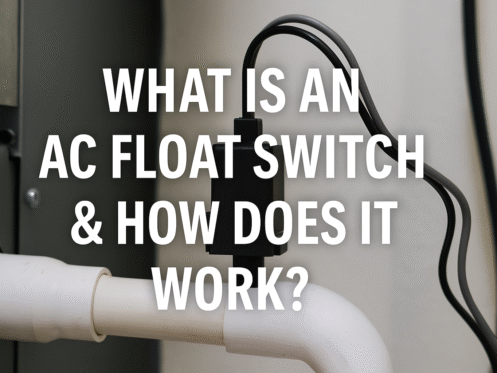Your air conditioner is a complex device with intricate inner workings that must function properly to produce cool, conditioned air in your home. Along with the compressor, condenser coil, expansion valve, fan, evaporator, and air handler, you’ll also find safety mechanisms like the AC float switch. This component stops flooding from occurring by preventing the drain pan from overflowing.
If you suspect that your AC is shutting off due to the float switch, HVAC experts at High 5 can help. We offer expert heating and cooling services in the Denver area, including minor repairs and maintenance tasks, as well as comprehensive AC system upgrades.
What Is an AC Float Switch?
Your air conditioner’s float switch is a safety mechanism found inside the AC unit’s drain pan. The drain pan, also known as a condensate pan, is where water collects after condensing on the evaporator coils during the cooling process. The drain line sends the collected water through a pipe or hose outside the home, or into a drain.
If the drain pan line gets clogged, the collected water fills the drain pan and eventually overflows. This is where the float switch comes in. The float switch detects the water levels inside the drain pan. When it reaches a certain point, the switch automatically turns your air conditioner off to prevent the pan from overflowing.
How Does an AC Float Switch Work?
An AC unit float switch is an overflow shut-off. It features a float that rises in tandem with the water level in the drain pan. When water reaches a certain level, the switch trips and disconnects the electrical circuit that brings power to the compressor, or the entire AC unit. This instantly turns the air conditioner off and prevents it from operating until the issue is resolved and the drain pan can be emptied.
Signs Your AC Float Switch May Be Activated
Depending on the type of air conditioner you have, the float switch may be easily accessible, allowing you to inspect it to determine if it has been activated. Look for these common signs of an activated float switch:
- Sudden loss of power to the air conditioner
- Error codes are displaying on your thermostat
- Water leaking from the air conditioner
- AC is short-cycling, or turning on and off rapidly
If you can’t find your float switch or you’re unsure whether it’s been activated, contact an HVAC professional for assistance.
Common Issues With AC Float Switches
There are several reasons why your air conditioner’s float switch may shut off power to the system.
Clogged or dirty condensate drain lines
If your condensate lines are clogged with debris, such as dirt, mold, and mineral deposits, the accumulated condensation from the cooling process has nowhere to go. The drain pan fills quickly, which sets off the float switch and cuts power to your cooling system. Cleaning out the drain line allows the water to flow normally again.
High 5 AC technicians are experienced in comprehensive AC maintenance services and repairs. If the condensate drain line is clogged, we have tools that’ll safely dislodge the blockage.
Malfunctioning or stuck
It’s possible for an air conditioner float switch to stop working correctly or become stuck in the “trigger” position. This usually happens due to corrosion, damage from debris, or years of use wearing out the float arm. A malfunctioning float arm requires replacement so your air conditioner can regain power and turn back on.
Incorrect installation
If an air conditioner float isn’t installed properly, it won’t accurately detect the water levels in the drain pan. This could either result in the switch triggering too soon, cutting power when it doesn’t need to, or too late, leading to flooding when the pan overflows. Installation by a skilled HVAC expert can prevent these issues, allowing you to enjoy cool comfort through the hot Colorado summers.
How To Troubleshoot & Maintain an AC Float Switch
If you’re wondering why your AC float switch keeps triggering, there are a couple things you can do to troubleshoot the issue.
Look at the float switch
The first place to check when you suspect a float switch issue is at the switch. If you can access it, look for visible damage or loose connections. Try lifting it gently to see if it triggers. If nothing happens, you’ll need to have it replaced.
Check the drain pan
The drain pan will offer clues to what’s happening if the float switch is triggered. If the pan is full of water and not draining, it can trigger the switch. Maintain your float switch by regularly inspecting your drain pan for algae growth, clogs, and other debris. You can also run vinegar through the drain line occasionally to keep it clean.
Do All AC Units Have a Float Switch?
Colorado building codes don’t mandate AC float switches, so not all air conditioners have them. If you’re unsure whether your air conditioner has a float switch or would like one installed, give us a call. We can install one in your system to enhance safety and prevent flooding, mold growth, and property damage.
Contact the Professionals at High 5 To Optimize Your Home’s HVAC Efficiency
Whether you want to schedule your annual AC tune-up or you need a float switch installed in your new cooling system, High 5 is here to help. Contact us today and discover why we’re a leading HVAC contractor in Denver. Our team is standing by, ready to help you. We offer all the HVAC services you need in one place.

